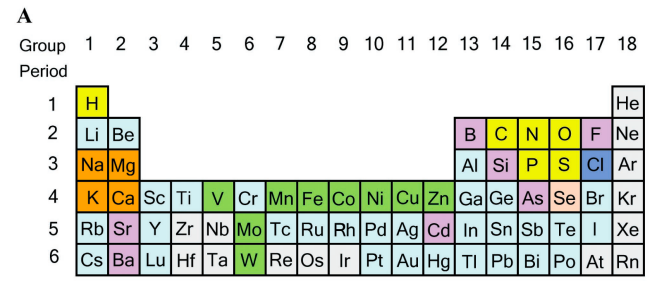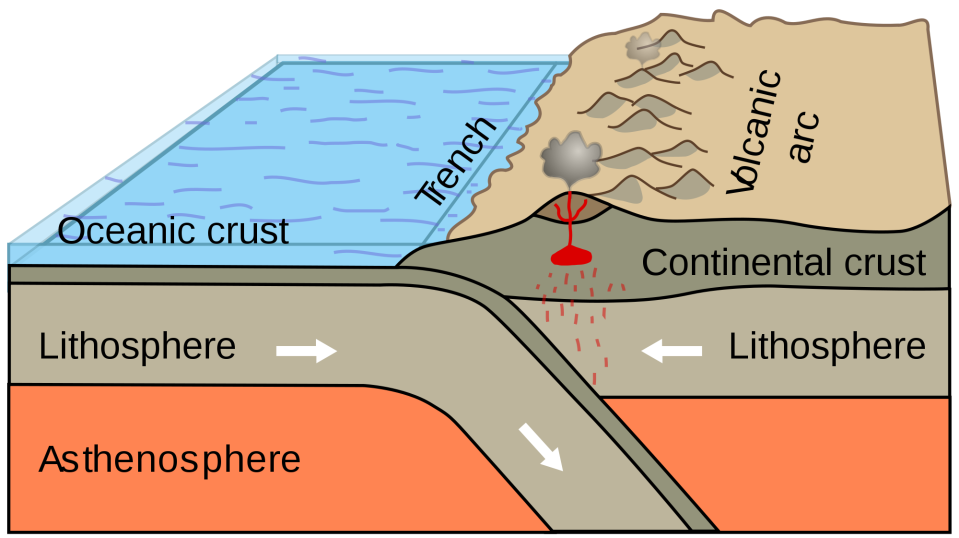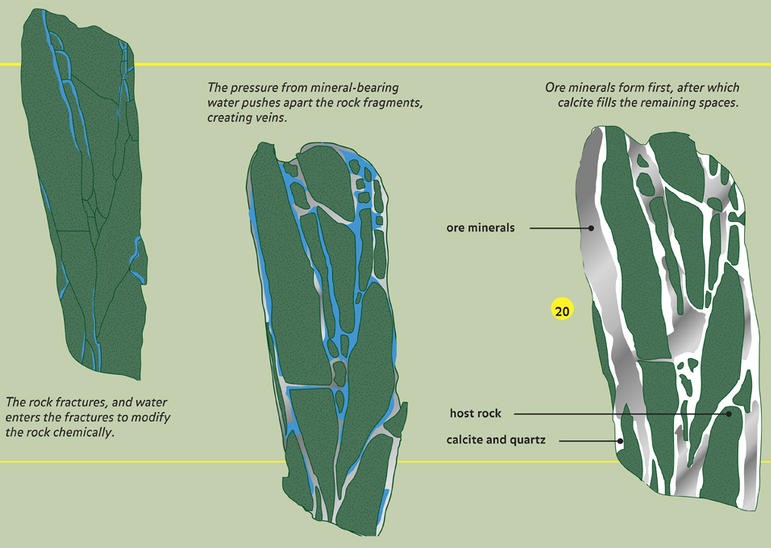Main idea: In previous units we have learned about metals and gems. We further learned about ores (rock that contains valuable minerals that can be mined and sold at a profit.)
In this unit we learn several ways that ore deposits were created in the first place. These processes are called ore genesis. (Not to be confused with the similar-sounding, but completely different, orogenesis.)
Pre-loading vocabulary
deposit (verb) – to put something down (e.g. money in a bank, or particles in a riverbed)
deposition (noun) – the process of silt and sediment building up in an area.
Here we see a GIF of particles moving through water, and eventually being deposited on the sea floor (deposition.)
Over long periods of time, this deposited material can be chemically cemented together into sedimentary rock. This is term sedimentation.
sedimentation (verb) – the process of particles settling or being deposited.
sedimentary rock (noun) – rock formed from fragments of other rocks or the remains of plants or animals.
element (noun) – Elements are pure substance made from a single type of atom. For all practical purposes, an element is something that cannot be broken down into anything simpler. Examples: Oxygen, Carbon, Hydrogen, Gold, Iron, etc.

Microbial Genomics and the Periodic Table, Lawrence P. Wackett, Anthony G. Dodge and Lynda B. M. Ellis
hydrothermal vent (noun) – An opening on the seafloor that emits hot, mineral-rich solutions.
mid-ocean ridge (noun) – underwater mountain range.

National Oceanic and Atmospheric Administration (NOAA), ETOPO1 Global Relief Model,
http://www.virginiaplaces.org/geology/rocksdui4.html
ore (noun) – deposit in the Earth of minerals containing valuable metal.
ore body (noun) – a well-defined mass of ore-bearing rock
subduct (verb) – When one tectonic plate hits another, and one of the plates is forced below the other. The subducted plate is the one going deeper into the mantle.
subduction zone (noun) – An area where one tectonic plate slides under another.
Deep versus surface processes
Sometimes we classify ore producing processes as either
supergene – those that occur near the surface.
hypogene – those that occur deep under the Earth’s surface.
Ways that ore deposits form
A National Geographic infographic describes three ways that ore deposits form:
(1) Ore deposits created underwater, within sedimentary rock like shale.
The rock/shale forms from nearby volcanic arc, settles on seafloor in layers. This sediment is rich in minerals that contain lead, silver, zinc.
As layer after layer of sediment build sup, the pressure on lower layers increases. The temp increases. The lower layers then begin to melt.
When sea water seeps in through cracks in the crust, the rocks expel these metals, which form ore bodies. Usually occurs within subduction zones.
(2) Subduction zone ore deposits.
Tectonic plates contain large quantities of water. As a tectonic plate is subducted into the mantle it heats up and releases this water. The resulting fluid travels up to the rocks above the subduction zone.
Combined with significant heat, this fluid-filled environment can create the right conditions for ore deposits to form. Includes Gold and copper.
(3) Hydrothermal vent ore deposits.
Deep sea hydrothermal vents line mid-ocean ridges. These vents spew incredibly hot water, which contains dissolved metals like copper, lead, zinc, and iron.
When this super heated liquid hits cold ocean water, the metals become solid and settle onto the ocean floor. Over time they build up on the seafloor near these vents, creating ore bodies than can be minded.
Looking on a global view, where do these processes occur?
See Compare and Contrast: Ore Deposition Infographic
Ores from hot water
This text is from the American Museum of Natural History
‘”Driven by heat from bodies of molten rock in the crust, hot water circulates through cracks, dissolving minerals in the rocks through which it passes. As the water moves into cooler rocks, the dissolved minerals precipitate and accumulate in fractures and cavities. Many metallic ore deposits, such as those represented in the samples shown here, form in this way.”
How weathering can produce ore deposits
Here are two examples of how weathering creates ores from Earth Science (Tarbuck, Lutgens, Tasa) This process is called secondary enrichment.
(A) Chemical weathering coupled with downward-percolating water removes undesired materials from decomposing rock.
This leaves the desired elements enriched in the upper zones of the soil.
(B) The second way is basically the reverse of the first. Desirable elements that are found in low concentrations near the surface are removed and carried to lower zones, where they are redeposited and become more concentrated.
Learning Standards
MS-ESS3-1. Construct a scientific explanation based on evidence for how the uneven distributions of Earth’s mineral, energy, and groundwater resources are the result of past and current geoscience processes.
[Clarification Statement: Emphasis is on how these resources are limited and typically non-renewable, and how their distributions are significantly changing as a result of removal by humans. Examples of uneven distributions of resources as a result of past processes include but are not limited to petroleum (locations of the burial of organic marine sediments and subsequent geologic traps), metal ores (locations of past volcanic and hydrothermal activity associated with subduction zones), and soil (locations of active weathering and/or deposition of rock).]
Disciplinary Core Ideas – ESS3.A: Natural Resources
Humans depend on Earth’s land, ocean, atmosphere, and biosphere for many different resources. Minerals, fresh water, and biosphere resources are limited, and many are not renewable or replaceable over human lifetimes. These resources are distributed unevenly around the planet as a result of past geologic processes.
Crosscutting Concepts – Influence of Science, Engineering, and Technology on Society and the Natural World
All human activity draws on natural resources and has both short and long-term consequences, positive as well as negative, for the health of people and the natural environment.
HS-ESS3-2. Evaluate competing design solutions for developing, managing, and utilizing energy and mineral resources based on cost-benefit ratios.
[Clarification Statement: Emphasis is on the conservation, recycling, and reuse of resources (such as minerals and metals) where possible, and on minimizing impacts where it is not. Examples include developing best practices for agricultural soil use, mining (for coal, tar sands, and oil shales), and pumping (for petroleum and natural gas). Science knowledge indicates what can happen in natural systems—not what should happen.]
4-ESS3-1. Obtain and combine information to describe that energy and fuels are derived from natural resources and their uses affect the environment.
HS-ESS3-4. Evaluate or refine a technological solution that reduces impacts of human activities on natural systems
[Clarification Statement: Examples of environmental effects could include loss of habitat due to dams, loss of habitat due to surface mining, and air pollution from burning of fossil fuels.]
_______________________












